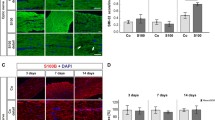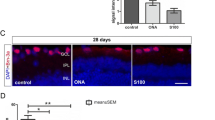Abstract
As previously shown, immunization with ocular antigens, like heat shock protein 27 (HSP 27), leads to retinal ganglion cell loss in an autoimmune glaucoma model. Aim of this study was to assess how immunization with S100 alone and in combination with HSP 27 affects retinal ganglion and macroglia cells. Rats were immunized with S100 or S100 plus HSP 27 (COMB). Neuronal cell density was evaluated on Nissl-stained flatmounts. Immunized groups showed a significant neuronal cell loss (S100, p = 0.005; COMB, p = 0.0005). A significant loss of retinal ganglion cells was also observed in both immunized groups on Brn-3a stained retinal cross-sections (S100, p = 0.003; COMB, p = 0.001). An increase in GFAP+ area was noted in both groups (S100, p = 0.01; COMB, p = 0.001). In contrary, vimentin staining was not altered (S100/COMB, p > 0.05). In summary, immunization with solely S100 leads to retinal ganglion cell damage and reactive gliosis. While the combination of S100 plus HSP 27 also caused retinal ganglion cell loss and a glia response, the combination of the two antigens did not cause additional damage or more severe cell loss. We assume that both antigens might interact, possibly having inhibitory effects on each other and thus preventing additional damage to the retina.





Similar content being viewed by others
References
Baudier J, Delphin C, Grunwald D, Khochbin S, Lawrence JJ (1992) Characterization of the tumor suppressor protein p53 as a protein kinase C substrate and a S100b-binding protein. Proc Natl Acad Sci U S A 89(23):11627–11631
Block ML, Zecca L, Hong JS (2007) Microglia-mediated neurotoxicity: uncovering the molecular mechanisms. Nat Rev Neurosci 8(1):57–69
Cuny CS, Joachim SC, Gramlich OW, Gottschling PF, Pfeiffer N, Grus FH (2010) Repeated intraocular pressure measurement in awake Lewis rats does not bias retinal ganglion cell survival. Curr Eye Res 35(11):1034–1039
Donato R (1991) Perspectives in S-100 protein biology. Review article. Cell Calcium 12(10):713–726
Donato R (2001) S100: a multigenic family of calcium-modulated proteins of the EF-hand type with intracellular and extracellular functional roles. Int J Biochem Cell Biol 33(7):637–668
EGS (2008) Terminology and guidelines for glaucoma. E. G. Society
Goncalves DS, Lenz G, Karl J, Goncalves CA, Rodnight R (2000) Extracellular S100B protein modulates ERK in astrocyte cultures. Neuroreport 11(4):807–809
Griffin WS, Stanley LC, Ling C et al (1989) Brain interleukin 1 and S-100 immunoreactivity are elevated in Down syndrome and Alzheimer disease. Proc Natl Acad Sci U S A 86(19):7611–7615
Griffin WS, Yeralan O, Sheng JG et al (1995) Overexpression of the neurotrophic cytokine S100 beta in human temporal lobe epilepsy. J Neurochem 65(1):228–233
Grus FH, Joachim SC, Bruns K, Lackner KJ, Pfeiffer N, Wax MB (2006) Serum autoantibodies to alpha-fodrin are present in glaucoma patients from Germany and the United States. Invest Ophthalmol Vis Sci 47(3):968–976
Grus FH, Joachim SC, Wuenschig D, Rieck J, Pfeiffer N (2008) Autoimmunity and glaucoma. J Glaucoma 17(1):79–84
Guo L, Moss SE, Alexander RA, Ali RR, Fitzke FW, Cordeiro MF (2005) Retinal ganglion cell apoptosis in glaucoma is related to intraocular pressure and IOP-induced effects on extracellular matrix. Invest Ophthalmol Vis Sci 46(1):175–182
Hernandez M, Rodriguez FD, Sharma SC, Vecino E (2009) Immunohistochemical changes in rat retinas at various time periods of elevated intraocular pressure. Mol Vis 15:2696–2709
Horstmann L, Schmid H, Heinen AP, Kurschus FC, Dick B, Joachim SC (2013) Inflammatory demyelination induces glia alterations and ganglion cell loss in the retina of anexperimental autoimmune encephalomyelitis model. J Neuroinflammation 10(1):120
Hu J, Castets F, Guevara JL, Van Eldik LJ (1996) S100 beta stimulates inducible nitric oxide synthase activity and mRNA levels in rat cortical astrocytes. J Biol Chem 271(5):2543–2547
Hu J, Ferreira A, Van Eldik LJ (1997) S100beta induces neuronal cell death through nitric oxide release from astrocytes. J Neurochem 69(6):2294–2301
Huttunen HJ, Kuja-Panula J, Sorci G, Agneletti AL, Donato R, Rauvala H (2000) Coregulation of neurite outgrowth and cell survival by amphoterin and S100 proteins through receptor for advanced glycation end products (RAGE) activation. J Biol Chem 275(51):40096–40105
Joachim SC, Pfeiffer N, Grus FH (2005) Autoantibodies in patients with glaucoma: a comparison of IgG serum antibodies against retinal, optic nerve, and optic nerve head antigens. Graefes Arch Clin Exp Ophthalmol 243(8):817–823
Joachim SC, Bruns K, Lackner KJ, Pfeiffer N, Grus FH (2007a) Antibodies to alpha B-crystallin, vimentin, and heat shock protein 70 in aqueous humor of patients with normal tension glaucoma and IgG antibody patterns against retinal antigen in aqueous humor. Curr Eye Res 32(6):501–509
Joachim SC, Wuenschig D, Pfeiffer N, Grus FH (2007b) IgG antibody patterns in aqueous humor of patients with primary open angle glaucoma and pseudoexfoliation glaucoma. Mol Vis 13:1573–1579
Joachim SC, Reichelt J, Berneiser S, Pfeiffer N, Grus FH (2008) Sera of glaucoma patients show autoantibodies against myelin basic protein and complex autoantibody profiles against human optic nerve antigens. Graefes Arch Clin Exp Ophthalmol 246(4):573–580
Joachim SC, Grus FH, Kraft D et al (2009) Complex antibody profile changes in an experimental autoimmune glaucoma animal model. Invest Ophthalmol Vis Sci 50(10):4734–4742
Joachim SC, Gramlich OW, Laspas P et al (2012) Retinal ganglion cell loss is accompanied by antibody depositions and increased levels of microglia after immunization with retinal antigens. PLoS One 7(7):e40616
Joachim SC, Mondon C, Gramlich OW, Grus FH, Dick HB (2014) Apoptotic retinal ganglion cell death in an autoimmune glaucoma model is accompanied by antibody depositions. J Mol Neurosci : MN 52(2):216–224
Kligman D, Hilt DC (1988) The S100 protein family. Trends Biochem Sci 13(11):437–443
Koppal T, Lam AG, Guo L, Van Eldik LJ (2001) S100B proteins that lack one or both cysteine residues can induce inflammatory responses in astrocytes and microglia. Neurochem Int 39(5–6):401–407
Laspas P, Gramlich OW, Muller HD et al (2011) Autoreactive antibodies and loss of retinal ganglion cells in rats induced by immunization with ocular antigens. Invest Ophthalmol Vis Sci 52(12):8835–8848
Mariggio MA, Fulle S, Calissano P, Nicoletti I, Fano G (1994) The brain protein S-100ab induces apoptosis in PC12 cells. Neuroscience 60(1):29–35
Nadal-Nicolas FM, Jimenez-Lopez M, Sobrado-Calvo P et al (2009) Brn3a as a marker of retinal ganglion cells: qualitative and quantitative time course studies in naive and optic nerve-injured retinas. Invest Ophthalmol Vis Sci 50(8):3860–3868
Neufeld AH, Hernandez MR, Gonzalez M (1997) Nitric oxide synthase in the human glaucomatous optic nerve head. Arch Ophthalmol 115(4):497–503
Pfeiffer N (2001) Glaukom: Grundlagen-Diagnostik-Therapie-Compliance, Pfeiffer, N. (Hrsg.). Stuttgart und New York: Georg Thieme Verlag
Qu J, Wang D, Grosskreutz CL (2010) Mechanisms of retinal ganglion cell injury and defense in glaucoma. Exp Eye Res 91(1):48–53
Quigley HA (1996) Number of people with glaucoma worldwide. Br J Ophthalmol 80(5):389–393
Quigley HA, Broman AT (2006) The number of people with glaucoma worldwide in 2010 and 2020. Br J Ophthalmol 90(3):262–267
Reichelt J, Joachim SC, Pfeiffer N, Grus FH (2008) Analysis of autoantibodies against human retinal antigens in sera of patients with glaucoma and ocular hypertension. Curr Eye Res 33(3):253–261
Rothermundt M, Missler U, Arolt V et al (2001) Increased S100B blood levels in unmedicated and treated schizophrenic patients are correlated with negative symptomatology. Mol Psychiatry 6(4):445–449
Sommer A, Tielsch JM, Katz J et al (1991) Relationship between intraocular pressure and primary open angle glaucoma among white and black Americans. The Baltimore Eye Survey. Arch Ophthalmol 109(8):1090–1095
Tezel G, Wax MB (2004) The immune system and glaucoma. Curr Opin Ophthalmol 15(2):80–84
Tezel G, Seigel GM, Wax MB (1998) Autoantibodies to small heat shock proteins in glaucoma. Invest Ophthalmol Vis Sci 39(12):2277–2287
Tezel G, Edward DP, Wax MB (1999) Serum autoantibodies to optic nerve head glycosaminoglycans in patients with glaucoma. Arch Ophthalmol 117(7):917–924
Verardo MR, Lewis GP, Takeda M et al (2008) Abnormal reactivity of muller cells after retinal detachment in mice deficient in GFAP and vimentin. Invest Ophthalmol Vis Sci 49(8):3659–3665
Wang X, Tay SS, Ng YK (2000) An immunohistochemical study of neuronal and glial cell reactions in retinae of rats with experimental glaucoma. Exp Brain Res 132(4):476–484
Wax MB, Tezel G, Yang J et al (2008) Induced autoimmunity to heat shock proteins elicits glaucomatous loss of retinal ganglion cell neurons via activated T-cell-derived fas-ligand. J Neurosci 28(46):12085–12096
Yang J, Tezel G, Patil RV, Romano C, Wax MB (2001) Serum autoantibody against glutathione S-transferase in patients with glaucoma. Invest Ophthalmol Vis Sci 42(6):1273–1276
Zimmer DB, Cornwall EH, Landar A, Song W (1995) The S100 protein family: history, function, and expression. Brain Res Bull 37(4):417–429
Acknowledgments
This work was supported by the German Research Foundation (DFG; grant JO 886/1-1).
Author information
Authors and Affiliations
Corresponding author
Additional information
C. Casola and J. E. Schiwek contributed equally and should therefore be regarded as equivalent authors.
Rights and permissions
About this article
Cite this article
Casola, C., Schiwek, J.E., Reinehr, S. et al. S100 Alone Has the Same Destructive Effect on Retinal Ganglion Cells as in Combination with HSP 27 in an Autoimmune Glaucoma Model. J Mol Neurosci 56, 228–236 (2015). https://doi.org/10.1007/s12031-014-0485-2
Received:
Accepted:
Published:
Issue Date:
DOI: https://doi.org/10.1007/s12031-014-0485-2




